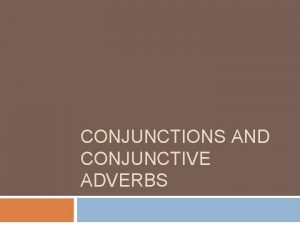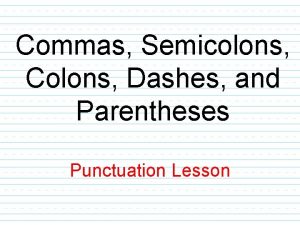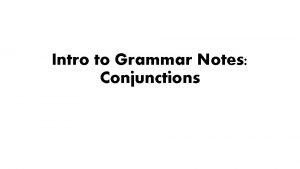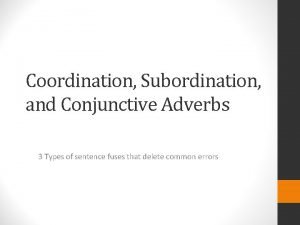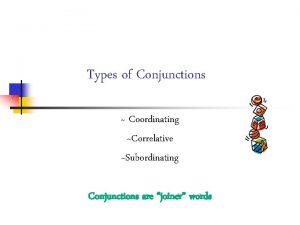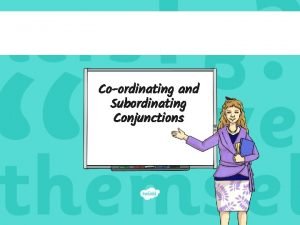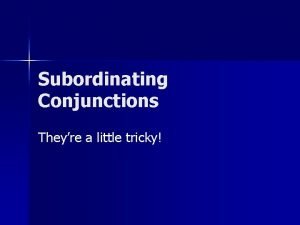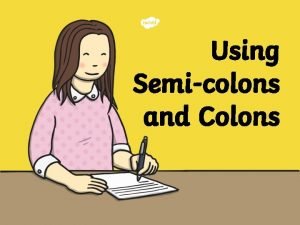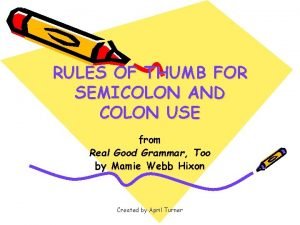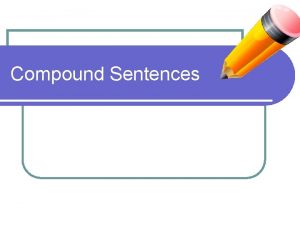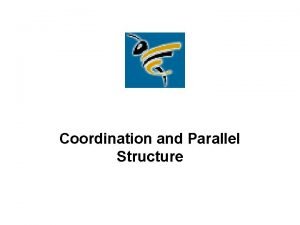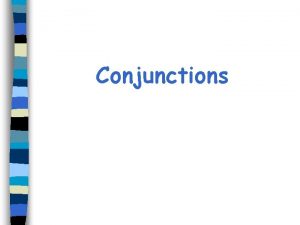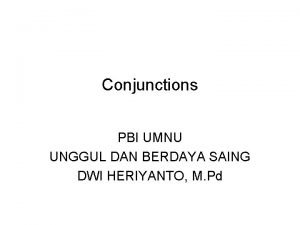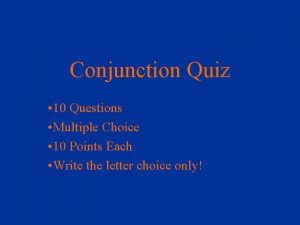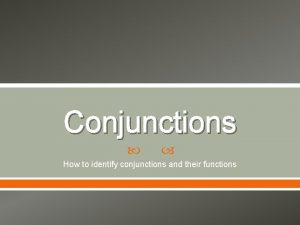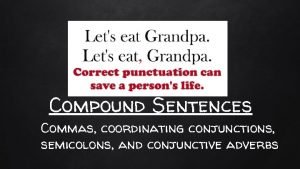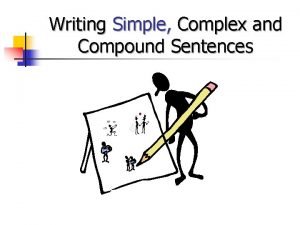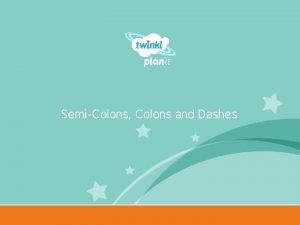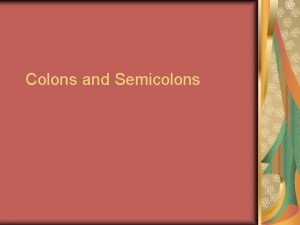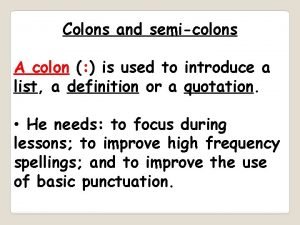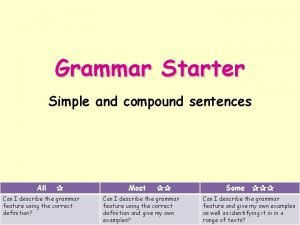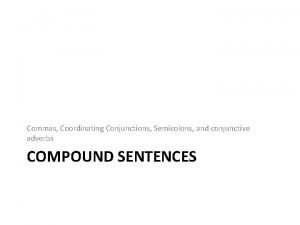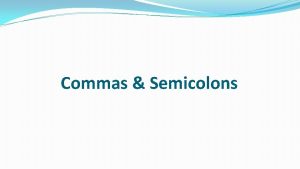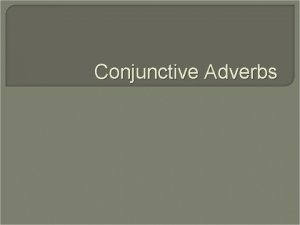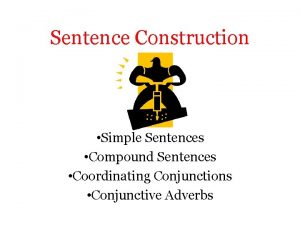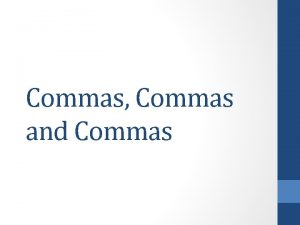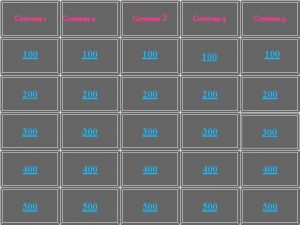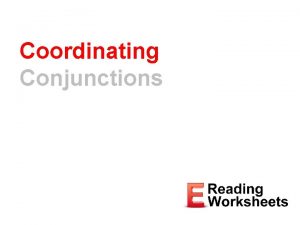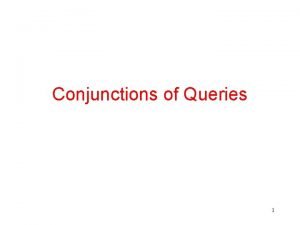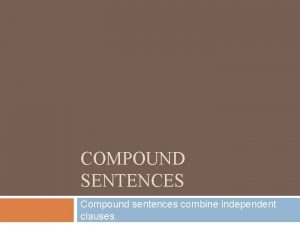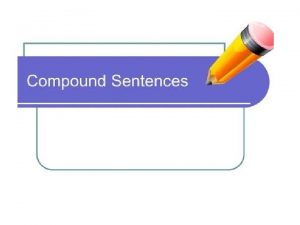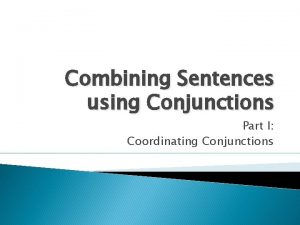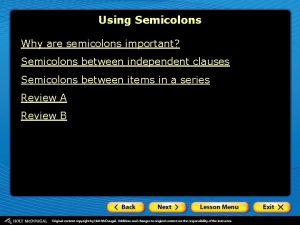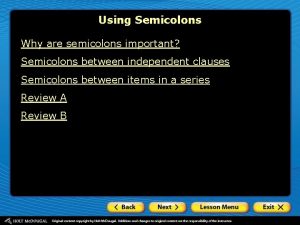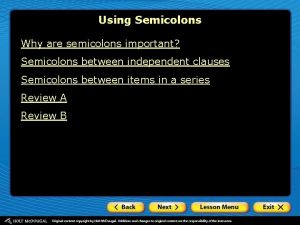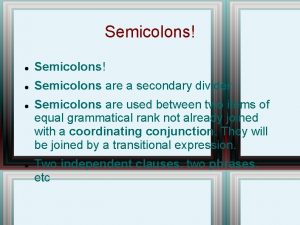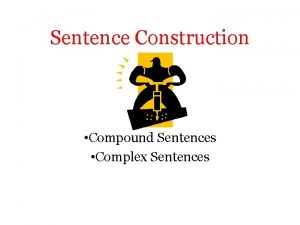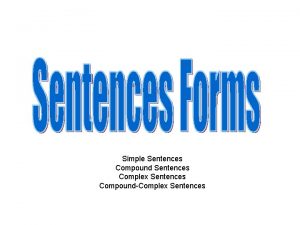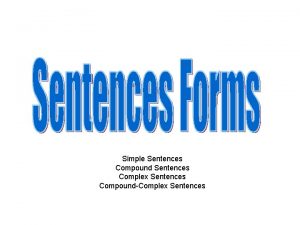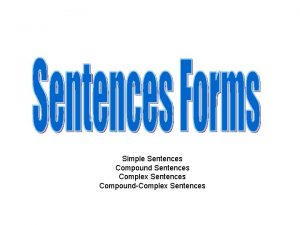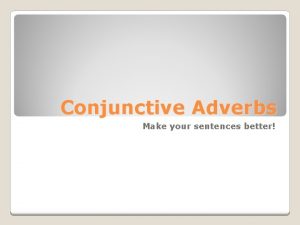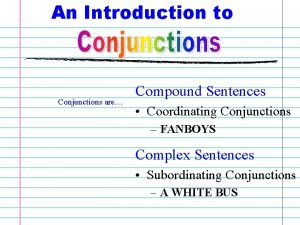Compound Sentences Commas coordinating conjunctions semicolons and conjunctive
























- Slides: 24

Compound Sentences Commas, coordinating conjunctions, semicolons, and conjunctive adverbs

Review: Simple Sentences ● A simple sentence is an independent clause; it can stand alone. ● Simple Sentence Patterns: SV/SVV/SSVV ● Simple sentences are the building blocks of all other sentence types.

Compound Sentences: Terms ● An independent clause is a simple sentence; it can stand alone. It contains a subject and a verb, and is a complete thought. ● A coordinating conjunction connects words, phrases, and clauses. ● A conjunctive adverb is an adverb that connects two independent clauses. They show relationships like cause and effect, sequence, contrast, and comparison.

COMMA RULES 1. Use a comma between two independent clauses that are joined by a coordinating conjunction. ○ Coordinating Conjunction = FANBOYS ○ Example: I ran to the store, but I did not buy anything. 1. Do NOT use a comma between compound subjects or compound verbs. ○ Example: I ran to the store and bought milk. 1. Use a comma after a conjunctive adverb. ○ Example: I ran to the store; however, I did not buy milk.

SEMICOLON RULES ● Use a semicolon to join two or more closely related independent clauses that are not connected with a coordinating conjunction (FANBOYS). Example: I ran to the store; I bought milk.

SEMICOLON RULES ● A conjunctive adverb is an adverb that connects two independent clauses. They show relationships like cause and effect, sequence, contrast, and comparison. Common Conjunctive Adverbs: also beside however meanwhile then therefore instead

SEMICOLON RULES ● A semicolon is used before a conjunctive adverb when it connects two independent clauses in a compound sentence. Example: I ran to the store; however, I forgot to buy milk.

COMPOUND SENTENCES ● A compound sentence has more than one part that can stand alone (independent clause). ● Independent clauses are connected by coordinating conjunctions, conjunctive adverbs, or a semicolon. We went to Buffalo Wild Wings, and most of us ate all night.

COMPOUND SENTENCES ● Compound Sentence Patterns: I = Independent Clause c = Coordinating Conjunction (FANBOYS) ca = Conjunctive Adverb Pattern Example I; I I went to the store; I bought milk. I, c I I went to the store, and I bought milk. I ; ca, I I went to the store; however, I didn’t buy milk.

#2 Compound Sentences

Remember! Compound sentences use: ✘Coordinating Conjunctions (FANBOYS) ✘Conjunctive Adverbs Compound sentences use commas and/or semicolons.

Compound Sentences Subject Comma Verb We went to Metro City, Predicate and most of us danced all night. { Coordinatin g Conjunction Subject Verb

Compound Sentences Hello from Metro

Compound Sentences using Coordinating Conjunctions (FANBOYS) Predicate, Subject coordinating conjunction Subject Predicate

Compound Sentences using Coordinating Conjunctions (FANBOYS) cooks, Spongebob and Plankton causes trouble.

! COORDINATING CONJUNCTIONS = FANBOYS For/And/Nor/But/Or/Yet/So

Compound Sentences Spongebob cooks Independent Clause #1 Plankton causes trouble. Independent Clause #2

Compound Sentences Spongebob cooks, and Plankton causes trouble. Remember! You need to place a comma BEFORE your coordinating conjunction.

Compound Sentences using Conjunctive Adverbs Predicate Subject conjunctive adverb, Subject Predicate

! CONJUNCTIVE ADVERBS also however meanwhile therefore beside instead then

Compound Sentences Spongebob is handsome; moreover, he is clever. Independent Clause #1 Independent Clause #2 Remember! Your semicolon goes before the conjunctive adverb and the comma is placed after it.

Here’s the curveball… Conjunctive Adverbs Float ● Conjunctive adverbs (ca) are sometimes called floating adverbs because they can be positioned at the beginning, in the middle, or at the end of a clause.

Conjunctive Adverbs: Beginning, Middle, and End ● Spongebob is handsome; moreover, he is clever. ● Spongebob is handsome; he is, moreover, clever. ● Spongebob is handsome; he is clever, moreover.

Compound Sentences Remember! The compound sentence patterns are: ● I ; I Patrick went to the store; he bought milk. ● I, c I Patrick went to the store, and he bought milk. ● I ; ca, I Patrick went to the store; however, he didn’t buy milk.
 Adverb conjunctions
Adverb conjunctions Interrupting comma examples
Interrupting comma examples Fanboys grammar
Fanboys grammar Conjunctive adverbs vs subordinating conjunctions
Conjunctive adverbs vs subordinating conjunctions Subordinating conjunction aaawwubbis
Subordinating conjunction aaawwubbis Acronym for subordinating conjunctions
Acronym for subordinating conjunctions Is until a subordinating conjunction
Is until a subordinating conjunction When to use a semi colon and colon
When to use a semi colon and colon When to use a semicolon examples
When to use a semicolon examples Rapidly in a sentence
Rapidly in a sentence Parallel structure with paired conjunctions
Parallel structure with paired conjunctions List of conjunctions
List of conjunctions Conjunctions ex
Conjunctions ex Conjunctions exercises multiple choice
Conjunctions exercises multiple choice How to identify conjunctions
How to identify conjunctions Coordinating conjunctions exemplos
Coordinating conjunctions exemplos Compound sentence with conjunctive adverb
Compound sentence with conjunctive adverb Bruno dislikes sitting on the beach
Bruno dislikes sitting on the beach Simple and compound sentences quiz
Simple and compound sentences quiz The cat crept through the dark house.
The cat crept through the dark house. Semicolon dash semicolon
Semicolon dash semicolon When do you use colon
When do you use colon Semicolon use list
Semicolon use list Fanboy sentences with commas examples
Fanboy sentences with commas examples What are the simple sentences
What are the simple sentences
